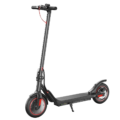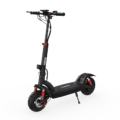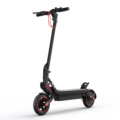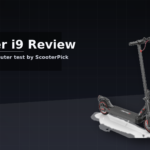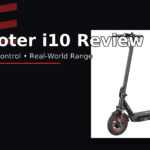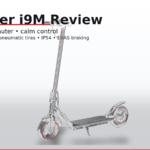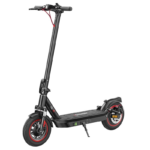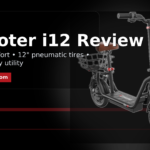- Home
- Scooters
- Electric Scooters
- iScooter i10 Pro
iScooter i10 Pro
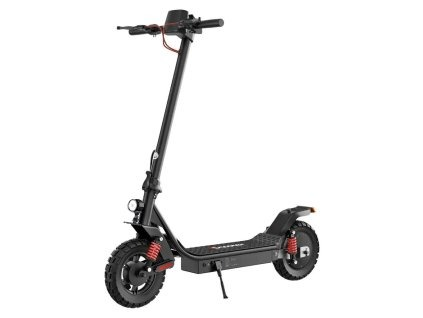

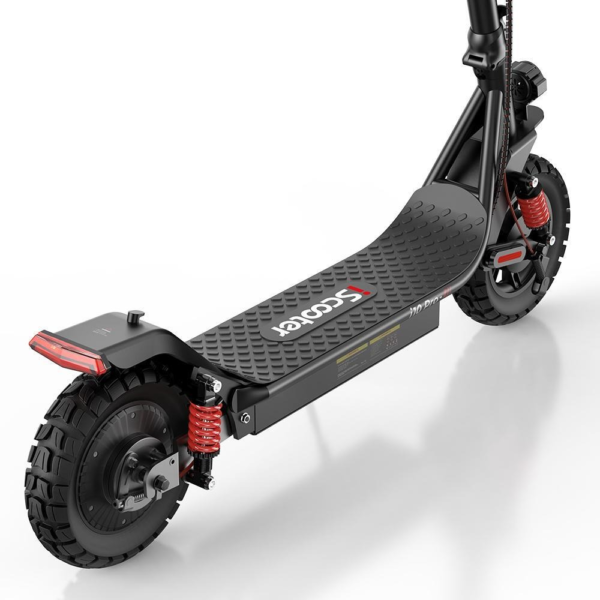
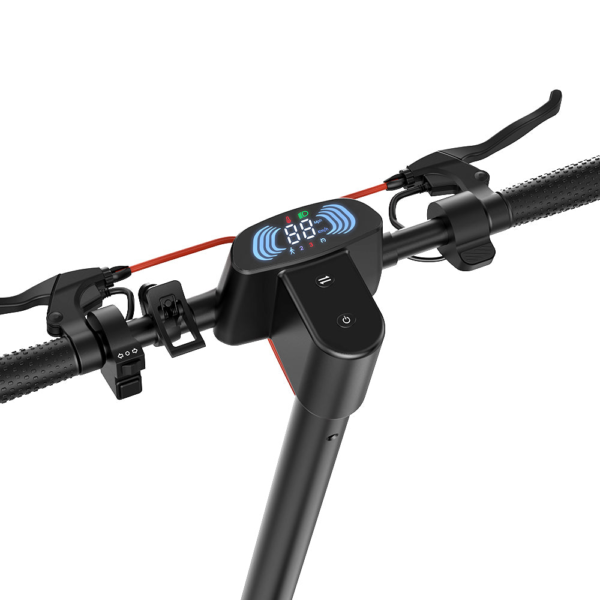
- Battery Range: 37 miles (60 km)
- Top Speed: 28 mph (40 km/h)
- Motor Power: 800 W rear hub
- Weight Capacity: 264 lb (120 kg)
- Charging Time: ~6–8 h
- Scooter Weight: 53.9 lb (25.0 kg)
PROS
- More motor torque for hills
- Dual suspension + 10″ tires
- EBAS + rear drum (manufacturer spec)
- iScooter App support
- IP54 water resistance
CONS
- Heavier than i10/i10 Plus
- Rear drum spec varies by listing
- Air tires need pressure checks
- Range depends on pace & temp

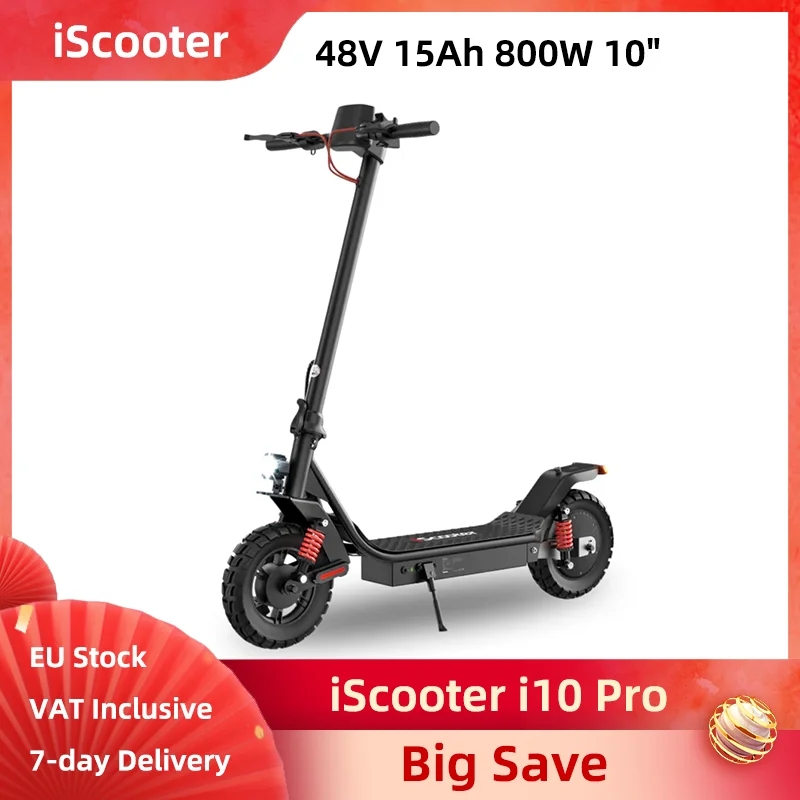

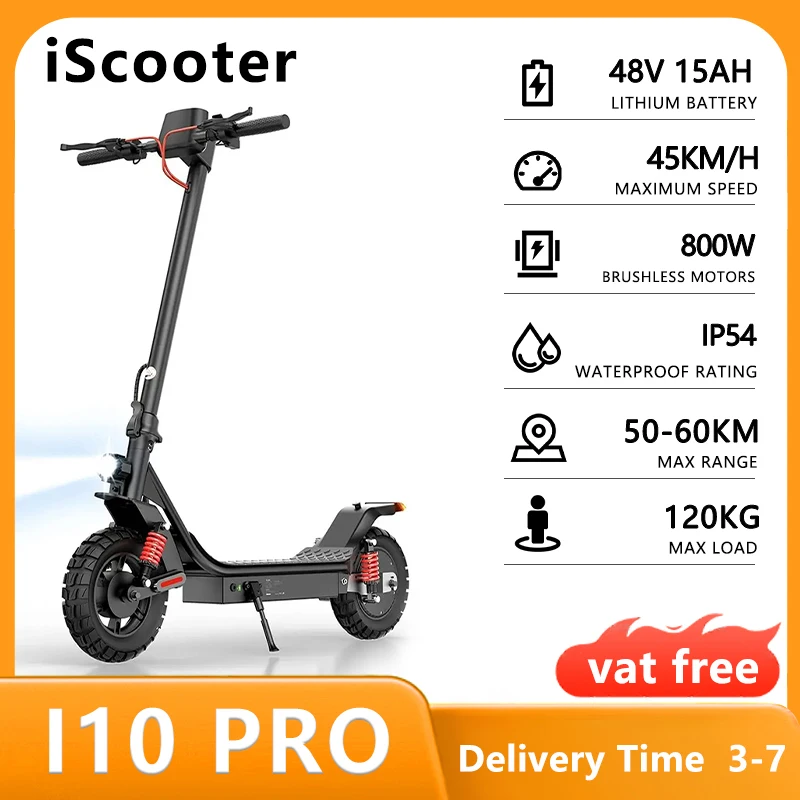

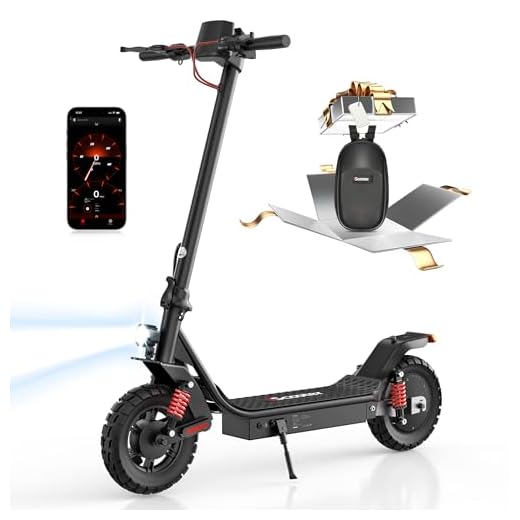
Table of contents
- What Is the iScooter i10 Pro?
- How the iScooter i10 Pro Works
- Key Specifications
- Design & Build Quality
- Performance Fundamentals
- Battery, Range & Efficiency
- Ride Quality & Comfort
- Braking & Safety Features
- Portability & Daily Usability
- Maintenance & Care
- Weather & Seasonal Considerations
- iScooter i10 Pro vs Alternatives
- Who the iScooter i10 Pro Is (and Isn’t) For
- FAQs
- Glossary
- Final Notes on Setup and Use
- Summary: Why This Scooter Works for Daily Riders
If you want a practical, low-maintenance commuter scooter with enough pep for daily errands, the iScooter i10 Pro checks a lot of boxes. It offers familiar controls, predictable handling, and a comfortable ride on city streets. Because it balances range, power, and weight, it suits new riders as well as returning commuters who want a reliable everyday partner. Moreover, it stays easy to live with even as your routes change.
What Is the iScooter i10 Pro?
The iScooter i10 Pro is a compact, foldable electric scooter designed for urban travel. It pairs a brushless rear-hub motor with a 36-volt battery and straightforward controls. Consequently, it feels intuitive from the first mile. You step on, press the throttle, and roll away—no learning curve, no complicated setup. In short, it’s built for short-to-medium commutes, quick store runs, and last-mile hops from transit to home. Additionally, its calm steering and simple interface make it beginner-friendly.
How the iScooter i10 Pro Works
Electric scooters share the same core parts, and this model follows that simple recipe.
Motor & Controller. The rear wheel houses a brushless DC hub motor. When you press the thumb throttle, the scooter’s controller meters power from the battery to the motor. Think of the controller as the “cruise director” that tells the motor how hard to push. Because the motor is inside the wheel, there’s no chain or belt to adjust. This design reduces upkeep and keeps road noise low. Furthermore, internal hall sensors and firmware smooth out the power curve.
Battery. A lithium-ion pack sits inside the deck. It stores energy in watt-hours, much like a water tank holds liters. The higher the watt-hours, the more “ride time” you get before refilling. An onboard BMS (Battery Management System) protects the pack during charge and discharge. In addition, the deck placement keeps the center of gravity low for stable cruising.
Throttle. The thumb throttle sends a signal to the controller. Press a little for gentle acceleration; press more for stronger pull. As a result, you can creep through crowded areas or merge with bike-lane traffic without jerky surges. Meanwhile, mode selection limits peak output when you want to extend range.
Brakes. The system typically pairs a mechanical rear disc with electronic regenerative braking in the front motor circuit. When you brake, the disc slows the wheel while the motor also resists rotation, turning some speed back into stored energy. It won’t “recharge” the pack in a big way, but it smooths stops and reduces pad wear. Notably, regen also helps in wet conditions by reducing abrupt lockup.
Lights & Display. A bright LED headlight and a rear brake light improve visibility. The bar-mounted display shows speed, mode, and battery status at a glance, so you can check essentials without taking your eyes off the path for long. Altogether, these parts turn a thumb press into smooth forward motion with minimal fuss.
Key Specifications
Measurements shown in both U.S. and metric units. These specifications reflect the model’s rated design and common equipment.
| Block | Item | Value |
|---|---|---|
| General | Model | iScooter i10 Pro |
| Intended Use | Urban/commuter, paved surfaces | |
| Rider Weight Limit | up to 264 lb (120 kg) | |
| Water Resistance | IP54 (splash-resistant) | |
| Performance & Power | Motor | Rear-hub brushless, 500 W nominal (≈800 W peak) |
| Top Speed (rated) | up to 18.6 mph (30 km/h) | |
| Climb Angle (rated) | up to ~15% (short hills) | |
| Ride Modes | 3 (Eco/Drive/Sport) | |
| Battery, Charging & Electrical | Battery | 36 V, 10.4 Ah (≈374 Wh) lithium-ion with BMS |
| Charger | 42 V, 2 A (typical) | |
| Charge Time | ~4–6 hours | |
| Claimed Range | up to 25 mi (40 km), ideal conditions | |
| Build & Dimensions | Frame | Aluminum alloy with reinforced stem latch |
| Tires | 10 in honeycomb (solid) tires | |
| Suspension | Dual spring suspension (front and rear) | |
| Unfolded (L×W×H) | ~44.9 × 16.9 × 46.5 in (1140 × 430 × 1180 mm) | |
| Folded (L×W×H) | ~44.9 × 16.9 × 19.3 in (1140 × 430 × 490 mm) | |
| Weight | ~37–38 lb (≈17 kg) | |
| Safety & Control | Brakes | Rear disc + front electronic regen (E-ABS) |
| Lighting | Front LED headlight, rear LED brake light, side reflectors | |
| Bell | Mechanical | |
| Features & Extras | Display | Handlebar LED/LCD, speed/mode/battery |
| Connectivity | Bluetooth app support (lock, ride settings, diagnostics) | |
| Cruise Control | Yes (when enabled) | |
| Folding | Quick-fold lever with safety catch | |
| Kickstand | Integrated side kickstand | |
| Warranty & Compliance | Warranty | Limited manufacturer warranty (term varies by region; often 12 months for core components) |
| Compliance | CE/RoHS; charger rated to relevant regional standards |
Note: Real-world performance varies with rider weight, temperature, tire condition, gradients, wind, and speed choices. Accordingly, treat rated figures as guideposts rather than guarantees.
Design & Build Quality
At first touch, the iScooter i10 Pro feels solid. The aluminum frame keeps weight reasonable while resisting daily dings. The deck has a grippy surface that stays secure in light rain. Because the battery sits inside the deck, the center of gravity stays low. That helps the scooter track straight at neighborhood speeds. Additionally, the tidy cable routing reduces snags and rattles.
The stem uses a quick-fold latch with a secondary catch. This two-step arrangement reduces accidental releases and keeps the lever tight after months of use. Importantly, the hinge resists play when you rock the bar forward and back. As a result, you get less “knock” and fewer vibrations through the hands. Moreover, the latch shape gives good leverage for secure closure.
The cockpit is simple. A central display shows speed, mode, and battery bars. The thumb throttle sits on the right. A brake lever sits on the left, above a mechanical bell. Grips are medium-diameter and have enough texture for gloved or bare hands. Because controls are symmetrical and close to your thumbs, you can keep elbows bent and shoulders relaxed. Meanwhile, the headlight mounting stays firm over rougher surfaces.
Wiring is tucked and routed along the stem. You’ll see external motor cables near the rear wheel, which makes tire or brake service easier. The rear fender is sturdy enough to shrug off road spray and minor scuffs. Overall, fit-and-finish feels tidy for this class; plus, the black hardware blends well with the frame.
Performance Fundamentals
Acceleration. Off the line, the throttle brings the motor in progressively. In Eco, takeoff is gentle. In Drive or Sport, it pulls stronger without feeling jumpy. Therefore, it’s easy to join bike-lane flow without surprise surges. Furthermore, the rear-hub layout adds traction as you shift weight back during launch.
Cruising Stability. At 12–16 mph (20–25 km/h), the scooter feels calm. The long deck and lower battery keep it planted, and the tires track predictably over seams. Because the stem is reinforced, side-to-side wobble is minimal at neighborhood speeds. If you move closer to the top of the speed range, keep knees slightly bent and weight light on the bars. That posture damps small oscillations before they grow. In addition, a relaxed grip reduces twitchiness.
Hill Behavior. On 7–10% grades, Sport mode helps preserve momentum. The scooter will slow, but it holds a useful pace on short climbs. Heavier riders will notice more drop-off, so approach steeper hills with a rolling start when possible. Additionally, keep your stance stable and eyes forward, since small bumps feel larger while the motor is working. Even so, traction remains consistent because the motor drives the rear.
Battery, Range & Efficiency
The pack is rated around 374 Wh (36 V × 10.4 Ah). In practice, range depends on speed. If you cruise near 12 mph (20 km/h) on flat paths in mild weather, you can approach the high end of the claim. However, if you weigh more than 180 lb (82 kg) or ride faster, expect less distance. Consequently, pacing and route choices matter.
Real-World Factors. Cold weather reduces cell output. Headwinds increase drag. Rough asphalt adds rolling loss. Even tire type matters. Honeycomb solids eliminate flats, yet they roll slightly “harder” than supple pneumatic tires. Therefore, you give up a little efficiency for zero-maintenance convenience. Conversely, you gain consistency because tire shape and diameter never sag.
Rider-Weight Examples (flat terrain, mild temps, mixed modes):
- ~140 lb (64 kg): about 18–25 mi (29–40 km)
- ~180 lb (82 kg): about 14–20 mi (23–32 km)
- ~220 lb (100 kg): about 10–16 mi (16–26 km)
Treat these as ranges, not promises. Speed choice has the biggest impact. If you want to stretch distance, ride in Eco or Drive, and avoid full-throttle sprints. Additionally, keep your rolling path smooth; fewer stops mean fewer energy-intensive starts.
Charging Best Practices. Allow the scooter to cool for 15–20 minutes before charging after a hard ride. Plug the charger into the wall first, then into the scooter. Unplug once the light turns green. For storage longer than a few weeks, charge to about 60–70% and top up monthly. These habits reduce stress on the pack and extend lifespan. Finally, avoid extreme heat during charging whenever possible.
Ride Quality & Comfort
The iScooter i10 Pro uses 10-inch honeycomb tires plus dual spring suspension. Solid tires resist punctures, so you ride stress-free through glass-prone areas. They also keep dimensions consistent because they never deform from incorrect pressure. As a result, the steering feel is predictable day to day. Meanwhile, the springs take the sting out of expansion joints.
Suspension Behavior. The springs take the edge off seams, curb cuts, and brick joints. While they won’t float you through potholes, they reduce chatter at bar and feet. If you stand with knees bent and ankles relaxed, your body adds a second “suspension stage,” further smoothing the ride. Additionally, the longer deck lets you shift weight to stay stable over rough patches.
Ergonomics. The deck gives enough space to stand with one foot forward and one back. That stance keeps your hips square and shoulders open. Because the bar height suits most adults, you won’t hunch. If you are very tall, rotate the bar slightly toward you to bring the controls closer without stressing your wrists. Moreover, the medium-diameter grips reduce hand fatigue on longer outings.
Stem Flex. All folding stems flex a little under load. Here, the movement is controlled and linear. It doesn’t bind or snap. Therefore, it reads as “comfort flex” rather than wobble. Even at higher neighborhood speeds, the feedback remains predictable.
Braking & Safety Features
Braking Feel. The rear disc has a clear bite point and good modulation. You can add electronic regen by easing off the throttle before you pull the lever. Together, they deliver strong, controlled stops in a short distance. Practice smooth, two-stage braking in a safe area: roll off, then squeeze. It builds muscle memory for wet days. Plus, it reduces front-end dive and keeps the chassis composed.
Lighting. The front LED casts a bright spot that helps you see and be seen. The rear light brightens under braking. Side reflectors catch headlights from cross traffic. For night riding, a small helmet-mounted light increases conspicuity at driver eye level. Additionally, reflective ankle bands move as you ride, drawing attention.
Ingress Protection. IP54 means it resists splash from all directions. You can ride through light drizzle and shallow puddle spray. However, avoid submersion, pressure washers, or heavy downpours. Water intrusion is the enemy of bearings and electronics. Accordingly, wipe the scooter dry after wet rides.
Speed Modes & Cruise. Three modes let you match pace to conditions. Eco conserves range and keeps speeds low near pedestrians. Drive balances pace and efficiency. Sport holds speed into mild headwinds and mild hills. Cruise control can reduce wrist strain on longer, steady paths, provided you enable it and use it responsibly. As always, stay alert and be ready to cancel cruise quickly.
Portability & Daily Usability
Fold-and-go is a core appeal. The stem latch releases, the bar folds toward the deck, and a catch secures it to the hook. The scooter fits under most desks and in car trunks. Because it weighs about 37–38 lb (≈17 kg), short carries up a flight of stairs are manageable for many adults. Even so, plan your grip and route before lifting.
Storage. Keep it in a dry, temperate place. Extreme heat ages batteries. Extreme cold saps range. If you store it near an entryway, use a floor mat to catch road grit and meltwater. Additionally, park it with the kickstand on firm, level ground to prevent tip-overs.
Security Habits. Electric scooters attract attention. Whenever possible, bring it indoors. If you must lock it outside briefly, use a high-quality U-lock through the frame, never through only the wheel or fender. Additionally, enable the app lock to deter casual tampering. Mark your scooter with a discreet ID label for recovery. Finally, avoid leaving it in the same outdoor spot every day.
Daily Flow. The display boots quickly. Modes cycle with a button press. You can check tire condition in a glance, since solids won’t go soft. Brakes hold adjustment for weeks with normal use. As a result, pre-ride checks take seconds. Meanwhile, the folding latch remains quiet if you keep it clean.
Maintenance & Care
Even low-maintenance scooters appreciate a light routine. A simple schedule prevents small issues from becoming big ones.
Before Every Ride (30–45 seconds).
- Squeeze the brake lever. Confirm firm feel.
- Check for play at the stem latch. Close it firmly if needed.
- Spin wheels. Look for debris, cracks, or unusual rubbing.
- Confirm lights work.
Weekly (10 minutes).
- Wipe dust from the deck and stem. Clean lenses on the lights.
- Inspect brake pads and rotor for wear or glazing.
- Check fasteners at the stem hinge, axle nuts, and caliper mounts. Tighten to spec if loose.
- Open the app to check for firmware prompts. Update only with a full battery and a stable connection.
Monthly (15–20 minutes).
- Inspect tires thoroughly. Honeycomb solids can still pick up sharp debris that causes vibration or noise.
- Check fenders and cable guides. Re-seat any clips that have shifted.
- Examine deck edges and kickstand screws.
Battery Care.
- Don’t store empty or at 100% for long periods. Aim for the 60–70% “middle.”
- Avoid repeated full-throttle sprints from 0 at very low charge; give the pack an easier life.
- If you won’t ride for a month, top the battery every 30–45 days.
Because you keep up with these small tasks, the scooter stays tight, quiet, and ready. Moreover, your braking and range remain consistent as parts bed in.
Weather & Seasonal Considerations
Rain. IP54 protects against splash, not immersion. Ride more conservatively in rain. Painted lines, steel plates, and wet leaves become slick. Therefore, slow earlier, brake smoother, and avoid sudden inputs. Dry the scooter after rides, especially the rotor, to prevent surface rust. Additionally, consider a reflective vest for dusk trips.
Cold. Lithium cells deliver less power in the cold. Expect temporarily reduced range below ~50°F (10°C) and a further drop near freezing. Start with a warm battery if you can. End rides gently before charging in cold garages. Meanwhile, keep speeds moderate so the controller can manage current without drama.
Heat. High temperatures stress batteries and tires. Park in shade. Let the pack cool before charging. In extreme heat, choose Eco or Drive to reduce thermal load on the controller and cells. Also, check the latch and brakes more often, since heat cycles can loosen hardware.
Wind. Headwinds matter. If the breeze stiffens, your range shrinks. Tuck elbows and keep speeds moderate to save energy. Conversely, tailwinds extend range; use them to arrive with more charge.
Because you adjust for weather, you maintain traction, protect the battery, and stay comfortable.
iScooter i10 Pro vs Alternatives
Commuter scooters fall into a few broad categories. The iScooter i10 Pro sits in the light/medium commuter class.
- Versus Lightweight Last-Mile Models. Those machines weigh less and fold smaller, yet they often skip suspension and use smaller wheels. As a result, they ride harsher and may struggle on rough asphalt. The i10 Pro’s larger tires and springs improve comfort without a big weight penalty. Additionally, its longer deck offers a more natural stance.
- Versus Mid-Tier Performance Scooters. Bigger scooters deliver more motor power and range, but they add 10–25 lb (4.5–11 kg). They also cost more and take more space. If you need regular 25+ mile (40+ km) trips or steep, extended hills, those models make sense. Otherwise, the i10 Pro covers daily needs with easier carrying. Meanwhile, maintenance remains simpler due to the single-motor layout.
- Versus Off-Road/All-Terrain Scooters. Off-road frames, knobby tires, and dual motors create huge traction and speed. However, they’re heavy and overkill for city paths. Urban riders gain more by choosing a nimble, efficient commuter with predictable manners. Consequently, the i10 Pro fits typical city infrastructure better.
If you want a similar package with a step up in configuration, consider the iScooter i10 Plus. It targets riders who prefer a bit more headroom while staying in the same practical, commuter-friendly family.
Who the iScooter i10 Pro Is (and Isn’t) For
Great For
- Daily commuters who want reliable range, clear lighting, and a smooth fold.
- Students crossing campus or hopping between neighborhoods.
- Multi-modal travelers who combine trains, buses, or rideshare with a compact scooter.
- New riders who value gentle throttle response and modest maintenance.
Not Ideal For
- Very steep terrain or long, continuous climbs above ~10% grade.
- High-speed thrill seekers who want motorcycle-like acceleration.
- All-weather riders who must ride through heavy rain or standing water.
Choose based on your routes, hills, and storage. When your needs match its design, it’s an easy scooter to live with. Plus, it scales from short errands to daily commutes without drama.
FAQs
1) How fast does it go, and can I adjust the speed?
Rated top speed is up to 18.6 mph (30 km/h). You can pick Eco, Drive, or Sport to match conditions. Cruise control is available when enabled, and it reduces wrist strain on steady paths.
2) What is the realistic range for daily commuting?
Most riders see 10–20 miles (16–32 km) depending on speed, weight, temperature, and terrain. Gentle pacing and mild weather push you toward the higher end. Conversely, cold and hills shorten range.
3) Can I ride it in the rain?
It carries an IP54 rating for splash resistance. Light rain is acceptable with caution. However, avoid heavy downpours, deep puddles, and pressure washing. Afterward, wipe it dry to protect hardware.
4) What maintenance does it need?
Check the stem latch, brake feel, and lights before rides. Wipe dust weekly. Inspect tires and fasteners monthly. Charge with care and store the battery at mid-level if unused. Consequently, long-term reliability improves.
5) Does it support an app, and what can I do with it?
Yes. You can view battery status, switch modes, enable cruise control, and lock the motor. Some firmware updates are also delivered through the app. As always, update on a stable connection.
6) Where can I find an “iScooter i10 Pro overview” in plain language?
You’re reading one. This guide explains how it works, what it does well, and how to care for it in daily use.
7) Is it good for first-time riders?
Yes. The throttle is friendly, the brakes are predictable, and the handling is stable. Start in Eco mode, practice braking, and move up as confidence grows. Meanwhile, keep both hands on the bar at all times.
Glossary
Ah (Amp-hours): A measure of battery capacity. Higher Ah means more stored charge.
Wh (Watt-hours): Voltage × amp-hours. A practical measure of energy and potential range.
BMS (Battery Management System): Electronics that protect the battery during charge and discharge.
Brushless Hub Motor: A motor built into the wheel; quiet and low-maintenance.
Controller: The scooter’s “brain” that meters power from the battery to the motor.
Regen (Regenerative Braking): The motor resists rotation to slow the scooter and recaptures a little energy.
E-ABS: Electronic anti-lock braking logic that reduces wheel lock-up by modulating regen.
IP Rating: Ingress protection against dust and water. IP54 means dust-protected and splash-resistant.
Stem Flex: The small elastic movement you feel at the folding bar under load.
Cruise Control: A feature that holds speed after a steady throttle press, reducing wrist strain.
Peak Power: Short-burst output the motor can deliver during acceleration or climbs.
Ride Modes: Preset power limits that balance speed and range for different conditions.
Watt-Hours per Mile: An efficiency metric; lower numbers mean better energy use.
Honeycomb Tire: A solid tire with internal voids that flex slightly and cannot puncture.
Mechanical Brake: A lever-actuated disc or drum brake that provides strong, reliable stopping.
Specifications: The scooter’s published design details such as power, battery, dimensions, and features.
Final Notes on Setup and Use
Because small setup steps pay dividends, spend ten minutes on day one:
- Tighten stem latch hardware to spec and confirm the secondary catch seats fully.
- Squeeze the brake and verify firm feel without rubbing.
- Turn on lights and check beam aim in a dark hallway.
- Enable or disable cruise control based on your preference.
- Take a short, low-speed test loop to confirm straight tracking and smooth throttle.
Next, build two habits:
- Charge strategy. After rides, let the scooter cool for 15–20 minutes before charging. Stop charging once the light goes green.
- Storage strategy. Keep it dry, out of direct sun, and away from freezing or scorching temperatures. If you pause riding for weeks, hold the battery near the middle.
These practices keep performance consistent and extend component life. Additionally, they protect the battery from avoidable stress.
Summary: Why This Scooter Works for Daily Riders
The iScooter i10 Pro earns its place as a steady commuter. It accelerates smoothly, folds quickly, and asks little in day-to-day care. The motor, controller, and suspension work together to deliver calm handling at realistic city speeds. Moreover, the solid tires and IP54 rating reduce stress when weather or debris show up uninvited. You get predictable brakes, useful lights, and an easy maintenance routine. If your routes are mostly paved and your rides stay within a practical distance, it’s a straightforward machine that fits busy life. Finally, it scales with you as your confidence and mileage grow.
Specifications
General
| Model The Model specifies the exact version or name of the scooter. It helps identify its unique design, features, and specifications within the manufacturer’s product line. Knowing the model makes it easier to compare options, find compatible accessories, or look up support information. | i10 Pro |
| Brand The Brand identifies the manufacturer or company that designs and produces the scooter. A trusted brand is a sign of quality, reliability, and good customer support. Well-known brands often have higher standards for safety, performance, and after-sales service, giving you more confidence in your purchase. | iScooter |
| Release Date The Release Date indicates when the scooter model was officially launched on the market. This helps you know how current the design, technology, and features are. A newer release date often means updated components, improved performance, and the latest safety or smart features. | 17 November 2025 |
| Recommended Age Recommended Age indicates the minimum age range that the scooter is designed for, based on safety, size, and ease of use. Following the recommended age helps ensure that riders can handle the scooter’s speed, weight, and controls comfortably and safely. Always check local laws and use protective gear, especially for younger riders. | Recommended 14+ |
Performance & Power
| Motor Power (Wattage) What it means: The motor power, measured in watts (W), shows how strong the scooter’s electric motor is. Why it matters: Higher wattage usually means better acceleration, more torque, and improved performance on hills or rough terrain. For example, a 250W motor is good for flat city roads and light riders, while a 500W or 1000W motor provides more power for faster speeds or climbing steep inclines. | 800 W rear hub motor |
| Top Speed The Top Speed indicates the maximum speed that the scooter can reach under optimal conditions. It’s usually measured on level ground with a fully charged battery and an average rider weight. A higher top speed allows you to travel longer distances faster, but always ensure you ride within legal speed limits and your personal comfort zone for safety. | 28 mph (40 km/h) |
| Battery Capacity Battery Capacity refers to the total amount of energy the scooter’s battery can store, usually measured in ampere-hours (Ah) or watt-hours (Wh). A higher battery capacity means you can ride longer distances on a single charge, reducing the need for frequent recharging. Keep in mind that actual range can vary depending on rider weight, terrain, speed, and weather conditions. | 48 V 15 Ah |
| Estimated Range per Charge The Estimated Range per Charge indicates the average distance the scooter can travel on a single full battery charge. This range is calculated under optimal conditions, such as flat terrain, moderate speed, and average rider weight. Real-world range may vary depending on riding style, terrain, weather, and load. A longer range means fewer recharges and greater freedom for longer trips. | Up to 37 miles (60 km) |
| Hill Climb Ability Hill Climb Ability describes the maximum incline or slope that the scooter can handle while maintaining stable performance. It’s typically expressed as a percentage or in degrees. A higher hill climb rating means the scooter can tackle steeper hills without losing too much speed or power. Actual climbing performance may vary based on rider weight, battery charge, and terrain conditions. | Not specified |
| Drive System The Drive System refers to how power from the motor is delivered to the wheels. Electric scooters typically use either a hub motor (directly integrated into the wheel) or a chain/belt drive system. A high-quality drive system ensures smooth acceleration, efficient power transfer, and low maintenance. The choice of drive system affects performance, noise level, and overall ride experience. | Rear wheel drive (RWD) |
Charging & Electrical
| Charging Time Charging Time indicates how long it takes to fully recharge the scooter’s battery from empty to 100% using the standard charger provided. Faster charging means less downtime and more time on the road. Actual charging time may vary slightly depending on battery capacity, charger output, and environmental conditions. | Approx. 6–8 hours |
| Battery Type Battery Type refers to the specific technology used in the scooter’s battery, which affects performance, lifespan, weight, and charging time. Most modern electric scooters use high-quality lithium-ion (Li-ion) batteries because they offer a good balance of energy density, durability, and low maintenance. A reliable battery type ensures consistent power delivery and longer riding ranges. | Lithium-ion pack |
| Removable Battery A Removable Battery means the battery pack can be easily detached from the scooter for convenient charging and replacement. This feature allows you to charge the battery separately, swap it with a spare for extended range, or securely store it indoors in extreme weather. Removable batteries add flexibility and make it easier to keep your scooter powered up wherever you are. | Non-removable internal battery (fixed pack) |
| Regenerative Braking Regenerative Braking is an energy-saving feature that converts some of the energy normally lost during braking back into battery power. When you slow down or brake, the motor works in reverse to generate electricity, which helps extend the scooter’s range and improves overall efficiency. This system also reduces wear on traditional brake components, leading to lower maintenance over time. | Yes (regen via EBAS electronic brake) |
| Lighting Lighting refers to the built-in front and rear lights that enhance visibility and safety when riding in low-light conditions or at night. Good lighting helps you see the road ahead and ensures that other road users can see you. Many scooters include LED headlights, taillights, and sometimes brake lights or side reflectors for added safety and compliance with local traffic regulations. | LED headlight + rear LED/brake + reflectors |
Build & Dimensions
| Scooter Weight Scooter Weight refers to the total weight of the scooter when fully assembled, including the battery. This affects how easy it is to carry, lift, and store the scooter when not in use. A lighter scooter is more portable and convenient for commuting, especially if you need to carry it upstairs or onto public transport. Keep in mind that a sturdy frame and quality components may add to the weight but also contribute to better durability and ride stability. | 53.9 lb (25.0 kg) |
| Maximum Rider Weight Maximum Rider Weight indicates the highest rider weight that the scooter is designed to safely support while maintaining optimal performance and stability. Staying within this limit helps ensure reliable acceleration, braking, and climbing ability, and it protects the frame, suspension, and motor from excessive strain. Exceeding the recommended limit may reduce performance and increase wear on components. | 264 lb (120 kg) |
| Deck Size Deck Size refers to the dimensions of the scooter’s standing platform. A wider and longer deck provides more foot space, allowing you to stand comfortably and adjust your stance while riding. A well-sized deck improves balance and stability, especially on longer rides or at higher speeds. Compact decks, on the other hand, help keep the scooter lightweight and portable. | Long deck; spring-damped chassis |
| Handlebar Height Handlebar Height refers to the distance from the deck to the handlebars, which affects your riding posture and comfort. An appropriate handlebar height helps you maintain good balance, reduces strain on your back and arms, and makes steering more comfortable. Some scooters have adjustable handlebars to fit riders of different heights, while others have a fixed height for a streamlined design. | Fixed bar height |
| Folding Mechanism The Folding Mechanism describes how easily and securely the scooter can be folded for carrying and storage. A well-designed folding system lets you quickly collapse the scooter into a compact size, making it convenient to transport on public transit, store under a desk, or fit into a car trunk. Look for sturdy latches and safety locks to ensure the scooter stays firmly in place when folded or unfolded. | Quick-folding latch |
| Dimensions Folded Dimensions indicate the size of the scooter when it’s fully folded. This measurement shows how much space the scooter will take up when stored or carried, making it easier to check if it will fit in your car trunk, under a desk, or in a closet. Compact folded dimensions are ideal for commuters who need to bring their scooter on public transport or store it in tight spaces. | Approx. 45.3 × 20.1 × 19.7 in folded / 45.3 × 20.1 × 45.3 in unfolded (manufacturer listing) |
| Material Material refers to the primary construction materials used for the scooter’s frame and key components. High-quality materials like aircraft-grade aluminum, reinforced steel, or durable composites provide strength, stability, and a lighter overall weight. A sturdy material ensures the scooter can handle daily wear and tear while maintaining safety and performance. | Aluminum alloy frame |
Safety & Control
| Brake Type(s) Brake Type(s) describe the braking systems the scooter uses to help you slow down or stop safely. Common brake types include mechanical brakes (like drum or disc brakes), electronic brakes, and foot brakes. Many scooters combine multiple braking systems for added safety and shorter stopping distances. The type and quality of brakes affect your control, especially when riding at higher speeds or on slopes. | Front EBAS electronic + rear drum (per iScooter Safety section) |
| Suspension Suspension refers to the system that absorbs shocks and vibrations while riding, providing a smoother and more comfortable ride over uneven or rough surfaces. Scooters may have front suspension, rear suspension, or dual suspension for better shock absorption and stability. Good suspension helps reduce rider fatigue and improves control, especially when riding on bumpy roads or off-road paths. | Front & rear spring suspension |
| Tire Type Tire Type refers to the kind of tires the scooter uses, which directly affects ride comfort, traction, and maintenance. Common types include solid (airless) tires, pneumatic (air-filled) tires, or hybrid options. Pneumatic tires offer better shock absorption and a smoother ride on rough surfaces, while solid tires are puncture-proof and require less upkeep. The right tire type helps ensure safe handling and a comfortable ride in different conditions. | Pneumatic road tires |
| Tire Size Tire Size indicates the diameter and width of the scooter’s tires, which affect ride comfort, stability, and how well the scooter handles different terrains. Larger tires generally offer better shock absorption and a smoother ride over bumps and rough surfaces, while smaller tires keep the scooter lighter and more portable. Choosing the right tire size helps ensure a balance between agility and comfort. | 10-inch |
| Kickstand The Kickstand is a built-in stand that allows you to park your scooter upright when it’s not in use. A sturdy kickstand keeps the scooter stable and prevents it from tipping over, protecting it from scratches and damage. It also makes storing and accessing your scooter more convenient, whether you’re at home, work, or on the go. | Side kickstand |
| Water Resistance Rating Water Resistance Rating indicates how well the scooter is protected against water and moisture, usually shown as an IP (Ingress Protection) rating. This rating helps you understand whether the scooter can handle light rain, splashes, or wet roads without damage. While most scooters are not fully waterproof, a good water resistance rating adds peace of mind when riding in changing weather conditions. Always avoid deep puddles or submerging the scooter to protect its electrical components. | IP54 body |
Features & Extras
| Display/Console The Display (or Console) shows important real-time information about your ride, helping you monitor your scooter’s status at a glance. Typical displays show speed, battery level, distance traveled, and riding mode. Some models also include additional features like Bluetooth connectivity, app integration, or backlighting for better visibility at night. A clear and easy-to-read display enhances safety and convenience on every trip. | Multi-functional LED display |
| Ride Modes Ride Modes refer to the different speed and power settings you can choose to match your riding style or road conditions. Common modes include eco for maximum range and energy efficiency, standard for everyday balance, and sport or turbo for higher speed and stronger acceleration. Switching between ride modes allows you to customize performance, conserve battery, and ride safely in various environments. | 3 modes |
| Smart App Connectivity Smart App Connectivity lets you pair your scooter with a dedicated mobile app via Bluetooth. Using the app, you can monitor real-time ride stats like speed, battery level, and range, adjust settings such as ride modes or cruise control, lock the scooter for added security, and sometimes receive firmware updates. This feature adds convenience and allows you to personalize your riding experience right from your smartphone. | iScooter App |
| Anti-Theft System The Anti-Theft System helps protect your scooter from unauthorized use or theft. This feature can include built-in alarms, electronic motor locks, GPS tracking, or remote locking through a mobile app. A good anti-theft system provides peace of mind when parking your scooter in public spaces, adding an extra layer of security to safeguard your investment. | App lock |
| Cruise Control Cruise Control allows you to maintain a steady speed without continuously holding the throttle. This feature makes longer rides more comfortable by reducing hand fatigue and providing a smoother, more relaxed riding experience — especially on flat, open roads or bike lanes. For safety, cruise control can usually be easily activated or deactivated while riding. | Yes (cruise control) |
| Accessories Included Accessories Included lists the additional items that come with the scooter to enhance your riding experience and convenience. Common accessories may include a charger, kickstand, bell, lights, phone holder, or carrying strap. These extras add value by making your scooter safer, easier to use, and ready to ride straight out of the box. | Bell, reflectors, charger, scooter bag |
Warranty & Compliance
| Warranty Period The Warranty Period indicates how long the manufacturer guarantees the scooter against defects in materials and workmanship under normal use. A good warranty provides peace of mind, showing the brand’s confidence in its product quality. Always check what parts are covered, such as the frame, battery, and motor, and follow the maintenance guidelines to keep your warranty valid. | 12 months (region-dependent) |
| Certifications Certifications confirm that the scooter meets specific safety, quality, and environmental standards set by recognized organizations or regulatory bodies. Common certifications may include CE, RoHS, UL, or other local compliance marks, depending on your region. These certifications ensure that the scooter is manufactured to high standards and is safe and legal to use in your country. | Local micromobility compliance |
Price Comparison








